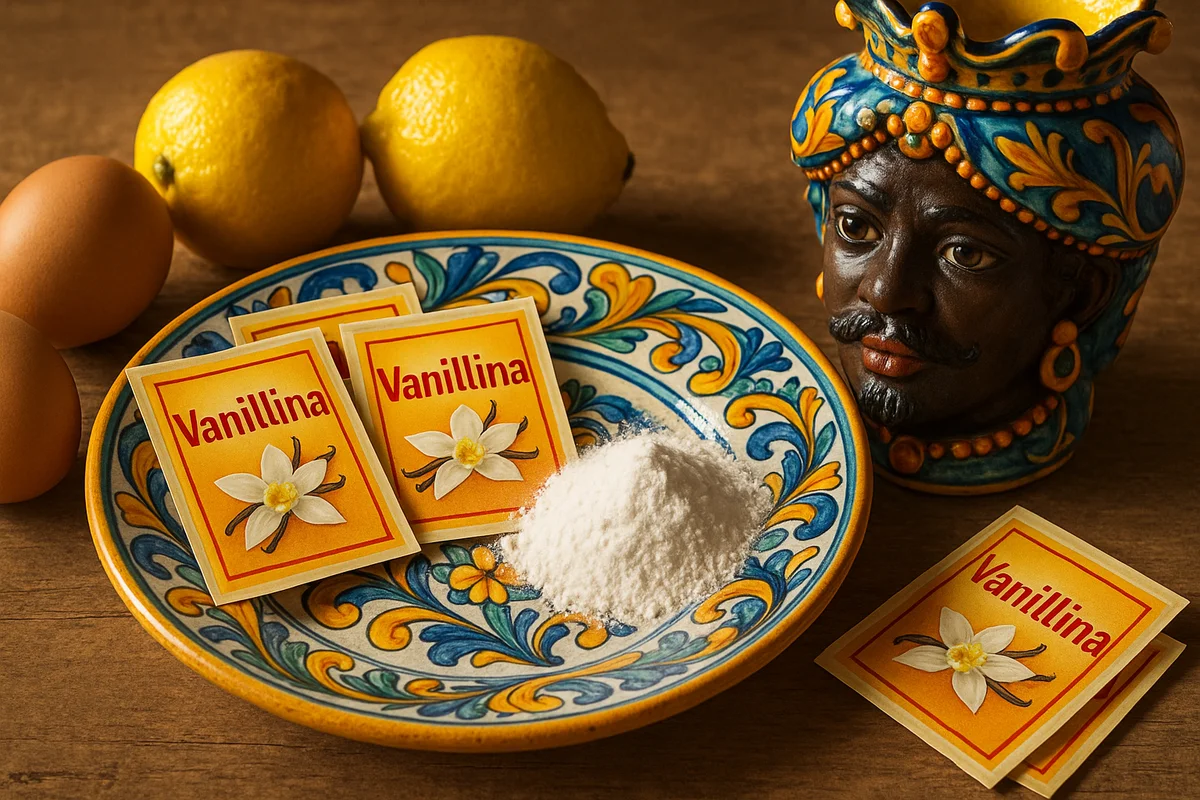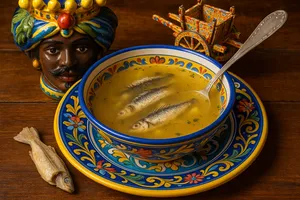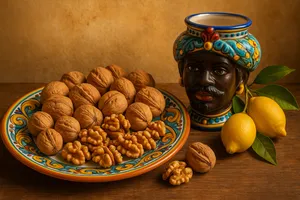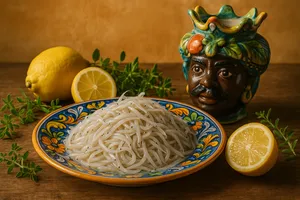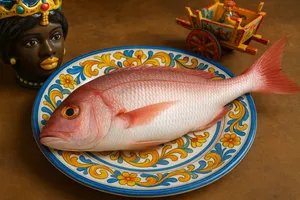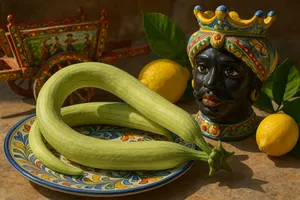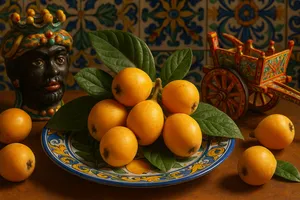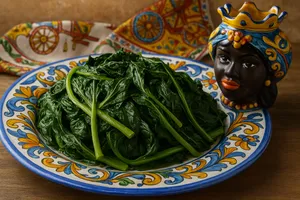Overview
Vanillin is the principal aromatic compound responsible for the characteristic fragrance of vanilla. It is an organic molecule (4-hydroxy-3-methoxybenzaldehyde) that can be extracted from natural vanilla pods—where it accounts for around 2% of their weight—or produced synthetically through various chemical processes. In true vanilla, vanillin is only one of more than 250 aromatic compounds that create its distinctive complexity, yet it is the dominant and most recognisable. Synthetic vanillin, produced industrially, is chemically identical to natural vanillin but lacks the aromatic depth of real vanilla. It is widely used in the food industry (cakes, ice creams, biscuits, chocolate, drinks) and in perfumery as an inexpensive vanilla-like flavouring. In Sicilian (and Italian) home cooking, powdered or sacheted vanillin is a common ingredient for flavouring homemade sweets, creams and biscuits when real vanilla is too costly or unavailable.
Vanillin represents a compromise between authenticity and convenience: it cannot replicate the intricacy of real vanilla, yet it provides a familiar aroma at a fraction of the price. It is part of collective olfactory memory: generations of Italians grew up with vanillin-flavoured desserts, a scent that evokes grandmother’s cakes, homemade biscuits and the simple, comforting ice creams of childhood. In Sicilian popular culture, “a sachet of vanillin” is synonymous with an all-purpose sweet aroma—an ever-present pantry staple whose little yellow envelope turns simple mixtures into fragrant treats. Vanillin evokes practical home baking, domestic economy, and the ingenuity of creating good things without excessive luxury.
Characteristics
Pure vanillin is a white or slightly yellowish crystalline substance with an intense, sweet vanilla fragrance, albeit flatter and more one-dimensional than natural vanilla, lacking its floral, caramelised and spicy notes. The flavour is sweet with a slight bitterness if overused. It dissolves easily in alcohol, oils and fats, but less readily in cold water.
Commercial vanillin for domestic use is available in various forms:
Powdered vanillin: Pure vanillin or vanillin mixed with sugar (vanilla sugar). Packaged in single-dose sachets (classic yellow 0.5 g sachets) or jars. The most common form in Italy.
Liquid vanilla flavouring: Vanillin dissolved in alcohol or propylene glycol, sometimes with additives (colourants, other aromas). More concentrated, used drop by drop.
Vanilla sugar: Sugar mixed with vanillin (typically 95% sugar, 5% vanillin). Convenient for sweets, replacing plain sugar while adding aroma.
Natural vanillin vs synthetic vanillin
Chemically, natural vanillin (extracted from vanilla pods) and synthetic vanillin (produced industrially) are identical molecules: same structure, same fragrance. The difference lies in the context:
Natural vanilla: Contains vanillin (2% by weight) plus over 250 aromatic compounds that build a rich, layered fragrance. It is expensive (pods: 3–10 euros each; natural extract: 20–40 euros per 100 ml). Its aroma is full, rounded and persistent.
Synthetic vanillin: Contains only vanillin, without any companion compounds. It is affordable (sachet: 0.20–0.50 euros). Its fragrance is flat, simple and “chemical” to discerning noses. It lacks the depth of real vanilla.
For home baking where vanilla is not the star (cakes, biscuits, simple creams), vanillin is acceptable and far cheaper. For refined preparations where vanilla must shine (custard for cannoli, panna cotta, artisanal gelato), real vanilla makes an enormous difference.
Production of synthetic vanillin
Synthetic vanillin is produced industrially via several processes:
From lignin: A by-product of paper manufacturing. A historical method (used until the 1980s), now less common due to environmental costs.
From guaiacol: Derived from petroleum or coal. A petrochemical, economical and widely used process.
From eugenol: Extracted from cloves. A more “natural” source, though still synthetic.
Biofermentation: A modern process using genetically modified bacteria to convert ferulic acid (from rice or maize bran) into vanillin. More sustainable and sometimes marketed as “natural”, though debated.
More than 99% of global vanillin production is synthetic. Vanillin extracted from natural pods accounts for less than 1%—far too expensive for mass-market use.
Use in Sicilian and Italian cooking
Homemade cakes
Vanillin is a standard ingredient in homemade cakes, sponge cakes, ring cakes and loaf cakes. One 0.5 g sachet per 500 g of flour is common. It lends a recognisable sweet fragrance.
Biscuits
Homemade biscuits (butter biscuits, almond biscuits, shortbread) are often flavoured with vanillin—an economical alternative to real vanilla.
Creams and puddings
Simple custards, puddings and filling creams may use vanillin when real vanilla is unavailable. The result is acceptable for home baking, though noticeably inferior.
Homemade ice cream
Homemade ice cream can be flavoured with vanillin. The result tastes of “vanilla”, though less complex than ice cream made with real vanilla.
Flavoured milk
A pinch of vanillin in warm milk (with sugar) yields a comforting sweet drink popular with children.
Vanilla sugar
Vanilla sugar (sugar + vanillin) is used for dusting desserts, flavouring coffee, or decorating sweets.
Vanillin sachets: an Italian classic
Single-dose sachets of vanillin (typically 0.5 g, in yellow packaging) are an icon of Italian home baking. Practical, inexpensive (0.20–0.50 euros), ubiquitous in supermarkets and kitchen cupboards. Generations of Italians learned to bake with “a sachet of vanillin” as a standard measure. They represent the democratisation of vanilla flavour: even those who cannot afford 5–10 euro vanilla pods can still make fragrant desserts.
Historic Italian brands (Paneangeli, Bertolini, Cameo) have produced vanillin sachets for decades, creating familiarity and trust. The ritual gesture of tearing open the yellow sachet and pouring the white powder into the mixture is part of Italy’s home-baking heritage.
Dosage
Vanillin is highly concentrated: small quantities suffice, and excessive use creates an unpleasant bitter, chemical aftertaste.
Typical domestic quantities:
- Cakes, ring cakes (500 g flour): 1 sachet (0.5 g) or less
- Biscuits (300 g flour): 1/2–1 sachet
- Creams (500 ml milk): 1/4–1/2 sachet
- Vanilla sugar: 5 g vanillin per 95 g sugar
Less is more: a hint of aroma is pleasant; too much becomes artificial.
Substituting real vanilla and vanillin
There is no perfect conversion because real vanilla is complex, vanillin one-dimensional. Roughly:
1 vanilla pod ≈ 1 teaspoon natural extract ≈ 1–2 sachets vanillin (0.5–1 g)
The result, however, will differ: real vanilla gives a rich, rounded fragrance; vanillin yields a simpler, more direct aroma.
Vanillin in the food industry
Vanillin is used extensively in industry to flavour:
- Industrial ice creams (most “vanilla” ice creams use vanillin, not real vanilla)
- Biscuits, snack cakes, packaged sweets
- Chocolate (especially milk chocolate)
- Drinks (milkshakes, flavoured beverages)
- Breakfast cereals
- Industrial baked goods
Labels should be read carefully: “natural vanilla flavour” may refer to natural extract or biofermentation vanillin (considered natural in the EU). “Vanilla flavour” or “vanillin” indicates synthetic origin.
Storage
Powdered vanillin (sachets, jars) keeps indefinitely if stored in a dry, cool place away from light and humidity. It practically never expires. Moisture can cause clumping, and light may slightly degrade aroma.
Closed sachets are virtually eternal. Once opened, they are best used within a few months for optimal fragrance, though they remain usable for much longer.
Vanillin vs ethylvanillin
Ethylvanillin is a related molecule with a fragrance two to four times stronger than vanillin. It is used in industry (chocolate, ice cream) to reduce costs as smaller quantities suffice. It is not common for domestic use and has a slightly different, more powerful yet less “natural” aroma.
Vanillin in perfumery
Vanillin is an important perfumery ingredient: a warm, sweet, enveloping base note much appreciated for its softness. Many famous perfumes contain vanillin (Shalimar by Guerlain, Hypnotic Poison by Dior, etc.). Perfumers also use synthetic derivatives (ethylvanillin, vanillyl ether) to create different nuances.
History of synthetic vanillin
Vanillin was first synthesised in 1874 by Ferdinand Tiemann and Wilhelm Haarmann in Germany, starting from glycosides found in conifer bark. It was one of the earliest natural aromatic substances to be replicated synthetically—a breakthrough that opened the way to modern aroma chemistry.
Industrial production began in the 1890s, making vanilla flavour accessible to the masses. Before then, only the wealthy could afford real vanilla; synthetic vanillin allowed everyone to enjoy vanilla-scented sweets.
Vanillin symbolises both the triumph and the limits of modern chemistry: we can replicate the single molecule but not the full complexity of nature’s ensemble of 250+ compounds. It is a lesson in scientific humility.
Controversies and perceptions
Synthetic vanillin is safe for human consumption and approved by all health authorities (FDA, EFSA). There are no health risks at normal food-use levels.
Nonetheless, negative perceptions persist: “synthetic = chemical = bad” versus “natural = good”. This is an oversimplification: synthetic vanillin is chemically identical to natural vanillin, and the body cannot distinguish between them. The difference lies in the aromatic context (presence or absence of additional compounds).
The debate over “natural vs synthetic” is complex: is biofermentation vanillin (from genetically modified bacteria) truly “natural”? Is vanillin extracted from industrial by-products (lignin) acceptable? There are no simple answers. For culinary use, the question is one of taste and budget: when possible, real vanilla; otherwise, vanillin is an acceptable alternative.
Curiosities
The word “vanillin” derives from “vanilla” plus the chemical suffix “-in” (used for alkaloids and organic compounds). It was coined when the molecule was first identified and isolated.
Vanillin occurs naturally not only in vanilla pods but also in small quantities in other foods: aged wine, whisky, beer, roasted coffee and cocoa. It forms during fermentation and roasting.
Castoreum, a secretion from beavers historically used in perfumery, contains natural vanillin. It was once used as a flavouring source (no longer, due to cost and ethical concerns). A curious piece of chemical history.
Vanillin crystallises readily: if a saturated solution of vanillin in alcohol is left to evaporate, beautifully fragrant white crystals form. It makes for an intriguing home chemistry experiment.
Vanilla ice cream is the world’s best-selling flavour, yet most people have never tasted ice cream made with real vanilla (only vanillin). Those who try Bourbon vanilla ice cream for the first time are often astonished by the difference.
In some cultures, “vanilla” is synonymous with “plain, basic, unadorned” (e.g., “vanilla version” in computing). Paradoxically, real vanilla is one of the most complex and expensive spices in the world.
Vanillin has mild antioxidant and antimicrobial properties documented in scientific studies. Quantities in food are minimal, but it remains an interesting chemical detail.
An old French chef once said: “Vanilla is queen; vanillin is servant.” A metaphor that captures the difference: real vanilla reigns with complexity; vanillin serves with economical efficiency but without nobility.
Producing the approximately 15,000 tonnes of vanillin used globally each year with natural vanilla would require cultivating an area the size of a small country. Synthetic vanillin has made the flavour of vanilla economically viable for billions of people.
Some culinary traditions employ tricks to “mask” vanillin and make it resemble real vanilla: adding a drop of dark rum, a pinch of caramelised sugar, or a hint of almond extract. These touches lend the complexity lacking in pure vanillin—tricks known to experienced grandmothers.

